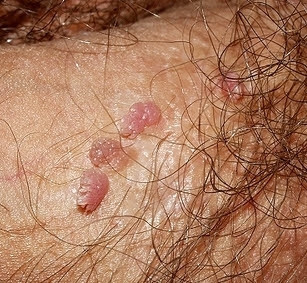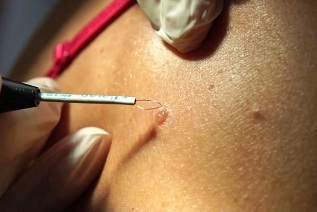
Often people do not suspect that human papillomavirus (HPV) has in their bodies. This is because the papilloma virus is usually present in a latent form that is suppressed by innate immunity. When it is out of control, problems arise and it begins to actively manifest itself in the form of growths in different parts of the body. Men are less likely to suffer from the effects of the virus than women, but for them the effect can turn into serious problems in the form of papillomas on the penis.
Reasons for occurrence
Viral DNA enters the body through micro-cracks in the skin or mucous membranes. If a man's immunity is weakened, the first symptoms of HPV will appear within a few months after infection.
Up to 80% of transmission occurs sexually. Barrier contraception minimizes the risk of infection, but does not eliminate it completely.
Other infection routes:
- Home path.The virus is transmitted along with personal items of an infected person: clothing, hygiene items, etc. If the skin is damaged, the risk of contamination increases, albeit small. This pathway is characterized by infection with low oncogenic strains of the virus. They do not cause serious health problems, but they do appear as genital warts, papillomas, and warts, creating a cosmetic defect.
- Mother to child.If the mother was infected with HPV during pregnancy and childbirth and gave birth naturally, the baby is likely to be infected.
If a person has a good immune defense, the virus will not show itself and can remain latent in the body for a long time. Therefore, it is not the infection with the virus itself that is dangerous, but the weakening of the immune system, which leads to the activation of HPV.
There are several factors that affect the possibility of the virus strengthening its location:
- chronic diseases;
- hormonal problems;
- incorrectly chosen birth control or its complete absence;
- viral infections;
- alcohol, smoking or long-term use of antibiotics;
- stress often.
All these factors negatively affect the immune system. If there are no provoking factors in a man's life, but several, this will lead to a faster development of the papilloma virus.
Symptoms
Usually papillomas only appear externally, but in some casesnonspecific symptoms may occur:
- itching and burning during sexual intercourse;
- pain when touching papillomas;
- urine accumulation in the penis folds;
- unpleasant odor in the affected area.
In addition, neoplasms can enlarge and appear not only in the penis area, but also in the anus and pubis.

What do papillomas look like
Penile papilloma is a small neoplasm. It may appear alone at first, but without proper treatment the number of papillomas increases. However, they can merge with each other.
These formations resemble tan or pink colored cauliflower inflorescences. Most often they are localized on the foreskin, head and frenum. Less commonly, they are diagnosed in the urethra and scrotum. Papillomas can also appear as small white pimples that appear in long rows. This form is typical for localization in the bridle area.
One of the manifestations ofHPV is Buschke-Levenshtein warts. It is distinguished by its rapid growth, extraordinary size and resistance to various types of treatment. Its appearance is due to several existing papillomas and warts that combine to form a large lesion area. The presence of Condyloma Buschke-Levenshtein is dangerous because the cells it changes can easily turn into cancer.
Which doctor to contact
As a rule, a urologist deals with the diagnosis of papillomas in men. If you have genital warts in the anal area, you can also get advice from a dermatovenerologist or proctologist. However, papillomas are often referred to a surgeon for removal. Diagnosis takes a total of several stages:
- The urologist examines the patient and talks to him.Verbal interrogation is necessary to assess the patient's lifestyle and determine the cause of the virus infection. Visual inspection includes not only the condition of the penis, but also the adjacent organs - the scrotum, anal area - to evaluate. This is necessary to complete the picture of the localization of the virus.
- Urethral smear.It determines the presence of various sexually transmitted diseases.
- PCR.This analysis not only shows the presence of HPV in the body, but also most likely determines its type.
- Meatoscopy.This procedure is to examine the urethra to see if the papilloma virus has infected the frenulum.
- After the papillomais removed, the doctor may request a biopsyto assess the condition of the removed tumor. This is necessary to eliminate the risk of developing cancer and to ensure that the papilloma is benign.
In this case, it is desirable to have a poll for both partners. Usually a woman will also become infected with one of the types of papilloma virus. If only one man is treated, he is very likely to fall ill again after a while.
Why are papillomas dangerous?
Human papilloma virus is often accompanied by other related diseases. The appearance of papillomas in the area of the head of the penis contributes to the accumulation of urine in the folds. This creates conditions for the emergence and growth of various microorganisms that subsequently cause infections. They can cause erosion around the papilloma and also contribute to inflammation of the urethra and testicles. These diseases are characterized by urination problems, pain, and high fever.
Another danger is trauma causing bleeding to neoplasms. This is because there are many blood vessels around the papillomas that supply them with blood. Even minor damage can lead to infection from injury.
Also, neoplasms can rub while moving, causing pain and discomfort in the human.
HPV and cancer
When the virus is just beginning to spread, neoplasms are irregular and benign. Without treatment, they grow and merge with each other. Over time, cells turn into malignant ones.The risk of cancer is particularly high if a man is infected with a high percentage of oncogenic virus strains (16 or 18).They are the contributors to the emergence of penis and bladder cancer.
Treatment of papillomas
HPV treatment includes not only relieving external symptoms, but also strengthening the immune system, which should block the symptoms of the virus.Immune stimulating drugs are used to protect immunity.
As an antiviral drug, an ointment that suppresses the reproduction of the virus and removes small growths is effective. It does not always cope with the task of removing it completely, but it prevents new growths from arising. Antiviral ointment is prescribed to stimulate immunity. The ointment does not destroy papillomas, but supports the activation of immune system cells, which stops their growth and development.

Removal methods
There are several ways to get rid of the new growths that occur:
- Laser removal.A laser beam acts on the papilloma, completely burning the growth. A crust is formed in this place, which decreases after a few weeks. The method is thought to be effective due to the absence of recurrence. Removal is done under anesthesia. No bleeding, no scar.
- Cryodestruction.Papillomas are exposed to liquid nitrogen. It instantly freezes the desired area, the neoplasm on it collapses and dies. The disadvantage of this method is that the depth of the cryodestruction effect cannot be controlled. A disappearing crust remains in the removed papilloma area after a while.
- Radiosurgery.The principle of this method is similar to laser extraction. Radio waves do not leave scars and pre-anesthesia is performed with a special spray before the procedure. After that, there are no complications and the body will recover quickly.
- Electrocoagulation.Growth is affected by electric current and the leg is eliminated and then papilloma disappears. Superficial anesthesia can be given if necessary. The process takes a few minutes, is common and economical. However, this method may leave a scar after healing.
- Surgical intervention.Used in rare cases when the tumor is very large. It is performed under anesthesia, it experiences a long recovery and trauma. The method is good in that it allows you to record the extracted growth for histological examination.
The cost of each method depends on the complexity of the job, the size and number of papillomas to be removed.
Consult your doctor before choosing a method. He will tell you what will be best used in your situation, tell you in detail how the procedure is done. Also, it is recommended to take the material for histology after removal of the neoplasm. This is necessary to determine whether the degeneration process has begun from benign neoplasms to malignant ones. This method will help detect early cell changes and prevent cancer from spreading.















































































